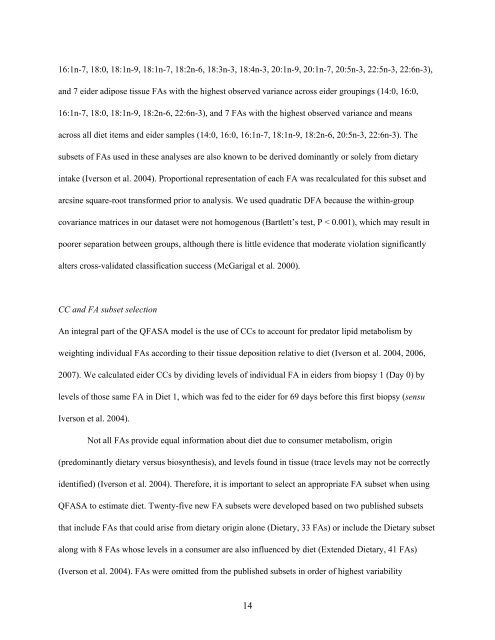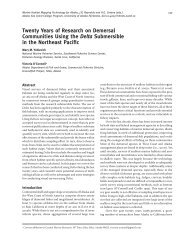724_Final Report.pdf - North Pacific Research Board
724_Final Report.pdf - North Pacific Research Board
724_Final Report.pdf - North Pacific Research Board
Create successful ePaper yourself
Turn your PDF publications into a flip-book with our unique Google optimized e-Paper software.
16:1n-7, 18:0, 18:1n-9, 18:1n-7, 18:2n-6, 18:3n-3, 18:4n-3, 20:1n-9, 20:1n-7, 20:5n-3, 22:5n-3, 22:6n-3),<br />
and 7 eider adipose tissue FAs with the highest observed variance across eider groupings (14:0, 16:0,<br />
16:1n-7, 18:0, 18:1n-9, 18:2n-6, 22:6n-3), and 7 FAs with the highest observed variance and means<br />
across all diet items and eider samples (14:0, 16:0, 16:1n-7, 18:1n-9, 18:2n-6, 20:5n-3, 22:6n-3). The<br />
subsets of FAs used in these analyses are also known to be derived dominantly or solely from dietary<br />
intake (Iverson et al. 2004). Proportional representation of each FA was recalculated for this subset and<br />
arcsine square-root transformed prior to analysis. We used quadratic DFA because the within-group<br />
covariance matrices in our dataset were not homogenous (Bartlett’s test, P < 0.001), which may result in<br />
poorer separation between groups, although there is little evidence that moderate violation significantly<br />
alters cross-validated classification success (McGarigal et al. 2000).<br />
CC and FA subset selection<br />
An integral part of the QFASA model is the use of CCs to account for predator lipid metabolism by<br />
weighting individual FAs according to their tissue deposition relative to diet (Iverson et al. 2004, 2006,<br />
2007). We calculated eider CCs by dividing levels of individual FA in eiders from biopsy 1 (Day 0) by<br />
levels of those same FA in Diet 1, which was fed to the eider for 69 days before this first biopsy (sensu<br />
Iverson et al. 2004).<br />
Not all FAs provide equal information about diet due to consumer metabolism, origin<br />
(predominantly dietary versus biosynthesis), and levels found in tissue (trace levels may not be correctly<br />
identified) (Iverson et al. 2004). Therefore, it is important to select an appropriate FA subset when using<br />
QFASA to estimate diet. Twenty-five new FA subsets were developed based on two published subsets<br />
that include FAs that could arise from dietary origin alone (Dietary, 33 FAs) or include the Dietary subset<br />
along with 8 FAs whose levels in a consumer are also influenced by diet (Extended Dietary, 41 FAs)<br />
(Iverson et al. 2004). FAs were omitted from the published subsets in order of highest variability<br />
14



